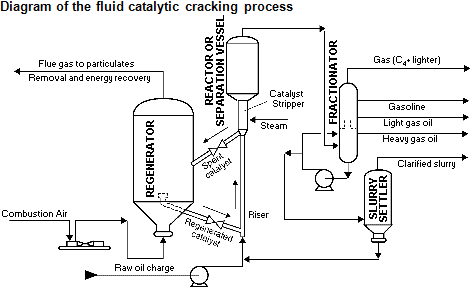Fluid catalytic cracking Plant
Background
The process of the FCC unit consists of the feed injection system, riser, riser outlet separator system, disengager/stripper, regenerator, catalyst cooler (optional), catalyst withdrawal well, catalyst transfer lines, and control systems.
General
The feed mixture is pumped to the base of the riser and divided into equal flows, to each of the feed nozzles. The feed, which has been preheated, is finely atomized and mixed with dispersion steam in the feed nozzles and injected into the riser. The small droplets of feed contact hot regenerated catalyst in a counter-current way and vaporize immediately. The vaporized oil intimately mixes with the catalyst particles and cracks into lighter, more valuable products along with slurry oil, coke, and gas. The product vapors travel up the riser while carrying the catalyst. Residence time in the riser is approximately 2 seconds at design conditions. The specially designed feed injection system ensures the reaction is carried out efficiently to minimize the production of coke, gas, and slurry oil.
Feed injection zone
Oil feed to the riser is preheated before entering the reaction system. Preheat temperature along with regenerated catalyst temperature is controlled to result in an optimum catalyst to oil ratio. Passivator injection into the fresh feed just ahead of the feed nozzles acts to inhibit the undesirable effects
Dispersion steam is supplied to each of the feed nozzles to promote atomization and vaporization of the feed. The flow to each of the feed nozzles is adjusted by flow controllers.
Upstream the feed injection, stabilization steam is injected in the riser, through the stabilization steam injectors, in order to promote a smooth and homogeneous catalyst flow at the feed injection point. The flow to each of the injectors is adjusted by flow controllers
